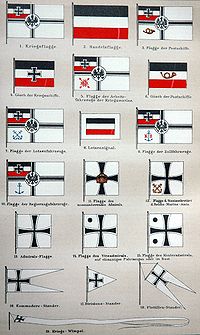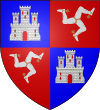Portal:Heraldry
Welcome to the Heraldry and Vexillology Portal!


Vexillology (from the Latin vexillum, a flag or banner) is the scholarly study of flags, including the creation and development of a body of knowledge about flags of all types, their forms and functions, and of scientific theories and principles based on that knowledge. Flags were originally used to assist military coordination on the battlefield, and have evolved into a general tool for signalling and identification, particularly identification of countries.
Heraldry encompasses all of the duties of a herald, including the science and art of designing, displaying, describing and recording coats of arms and badges, as well as the formal ceremonies and laws that regulate the use and inheritance of arms. The origins of heraldry lie in the medieval need to distinguish participants in battles or jousts, whose faces were hidden by steel helmets.
Selected article

Heraldry in its most general sense encompasses all matters relating to the duties and responsibilities of officers of arms. To most, though, heraldry is the practice of designing, displaying, describing, and recording coats of arms and badges. Historically, it has been variously described as “the shorthand of history” (Fox-Davies) and “the floral border in the garden of history” (Moncreiffe & Pottinger). The origins of heraldry lie in the need to distinguish participants in combat when their faces were hidden by iron and steel helmets. Eventually a system of rules developed into the modern form of heraldry. Though heraldry is nearly 900 years old, it is still very much in use. (more...)
Selected flag

The Eureka Flag is a design which features: a dark blue field 260 x 400 cm (2:3.08 ratio); a horizontal stripe 37 cm wide and a vertical line crossing it of 36 cm wide; and 5 eight pointed stars, the central star being 65 cm tall (point to point) and the other stars 60 cm tall, representing the Crux Australis constellation. The design was first used for the war flag of the Eureka Rebellion of 1854 at Ballarat in Victoria, Australia.
The flag design has gained wider notability due to its adoption in Australian culture as a symbol of democracy, protest and other causes. It is listed as an object of state heritage significance on the Victorian Heritage Register and was named as a Victorian Icon by the National Trust in 2006. (more...)
Selected biography

Emily Dickinson (born Emily Elizabeth Dickinson; December 10, 1830 – May 15, 1886), was an American poet who wrote about 1,800 poems in her lifetime and posthumously became an influence on American poetry. Her work when she was alive was very little-known and during her life she often stayed confined to her bedroom in her home in Amherst, Massachusetts, after leaving society in her 30s. She lived in Amherst, Massachusetts her entire life. In 1955, a complete published print of all of her poems became available in The Poems of Emily Dickinson by Thomas Johnson. (more...)
Selected picture

Flags used by the German Kaiserliche Marine (Imperial Navy), 1892.
Did you know...
- ...that the triskelion (pictured) in MacLeod heraldry originates from a belief that the clan's founder, Leod, was a son of a king of Mann?
- ...that artist Corwin Clairmont designed the Salish-Kootenai's tribal seal when he was 15 and it is still used today?
- ...that Albany, New York has a life-size version of its coat of arms that was sculpted by a local political cartoonist?
- ...that the Raven banner, a standard used by various Viking leaders including Sigurd the Stout and Harald III of Norway, was a totem believed to have the power to grant victory to its holder?
- ...that in The Stages of Life, German painter Caspar David Friedrich depicted his son holding a Swedish flag because Friedrich considered himself half-Swedish?
Related portals
|
|
|
Heraldry Web resources
Authorities
- Belgium - The Council of Nobility, Flemish Heraldic Council and Council of Heraldry and Vexillology of the French Community
- Canada - Canadian Heraldic Authority and see also Public Register of Arms, Flags and Badges
- England, Wales, and Northern Ireland - The College of Arms
- Ireland - The Office of the Chief Herald of Ireland
- Netherlands - High Council of Nobility
- Portugal - Instituto da Nobreza Portuguesa
- Scotland - The Court of the Lord Lyon
- South Africa - South African Bureau of Heraldry
- Sweden - National Board of Heraldry, The National Archive
- United States Army - The United States Army Institute of Heraldry
Societies
- Greek Heraldry Society
- The Academy of Heraldic Science Czech republic
- The American College of Heraldry
- The American Heraldry Society
- The Augustan Society
- The Australian Heraldry Society Inc.
- Bulgarian Heraldry and Vexillology Society
- The Center for Research of Orthodox Monarchism
- Cambridge University Heraldic and Genealogical Society
- Chiltern Heraldry Group
- The College of Dracology
- Croatian Heraldic and Vexillologic Association
- The Finnish Heraldic Society
- Fryske Rie foar Heraldyk
- Hellenic Armigers Society
- Guild of Heraldic Artists
- Genealogical Society of Ireland
- Heraldry Research Institute (Japan)
- The Heraldry Society
- The Heraldry Society of Africa
- The Heraldry Society of New Zealand Inc.
- The Heraldry Society of Scotland
- The Heraldry Society of Southern Africa
- The Institute of Heraldic and Genealogical Studies
- The International Association of Amateur Heralds
- Italian Center of Vexillological Studies
- Lancashire Heraldry Group
- Macedonian Heraldry Society
- New England Historic Genealogical Society Committee on Heraldry
- Norwegian Heraldry Society
- Oxford University Heraldry Society
- Polish Heraldry Society
- Polish Nobility Confederation
- Real Academia Matritense de Heráldica y Genealogía - Royal Academy of Heraldry and Genealogy of Madrid
- Romanian Institute for Genealogy and Heraldry
- The Royal Heraldry Society of Canada
- The Russian College of HeraldryThe Russian College of Heraldry
- Serbian Heraldic Society
- Societas Heraldica Scandinavica
- Societas Heraldica Slovenica
- Swedish Heraldic Society
- Ukrainian Heraldry Society
- Royal Association Genealogical and Heraldic Office of Belgium
Vexillology
Software
- Coat of Arms Visual Designer web-based program
- Puncher Heraldry Program
- Blazonry Server - pyBlazon
- DrawShield - creates SVG shield or arms image from blazon
- CoaMaker - web-based tool
- Blazon95 and BLAZONS! 2000, older Windows applications
Texts
- Heraldry, historical and popular : with seven hundred illustrations (1863)
- A Complete Guide to Heraldry (1909)
Other
Wikimedia
The following Wikimedia Foundation sister projects provide more on this subject:
-
Commons
Free media repository -
Wikibooks
Free textbooks and manuals -
Wikidata
Free knowledge base -
Wikinews
Free-content news -
Wikiquote
Collection of quotations -
Wikisource
Free-content library -
Wikispecies
Directory of species -
Wikiversity
Free learning tools -
Wikivoyage
Free travel guide -
Wiktionary
Dictionary and thesaurus












